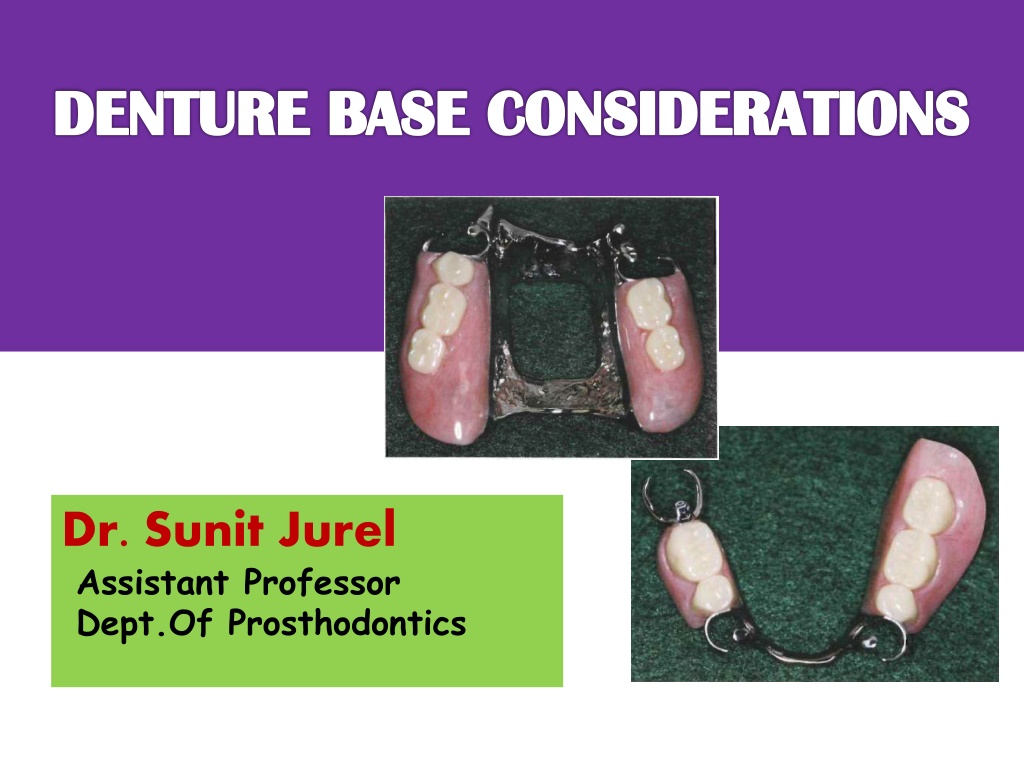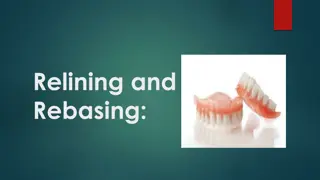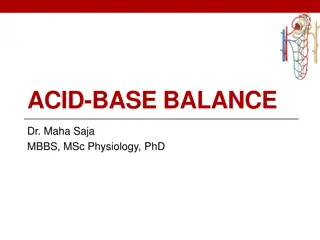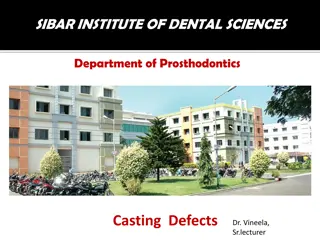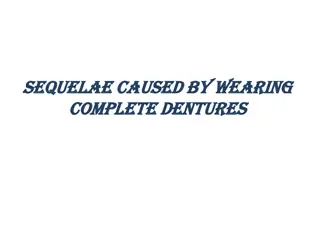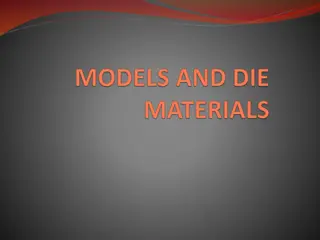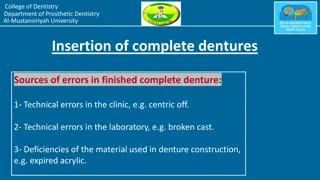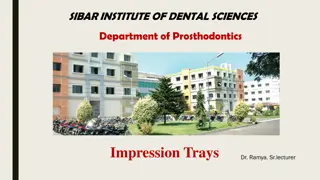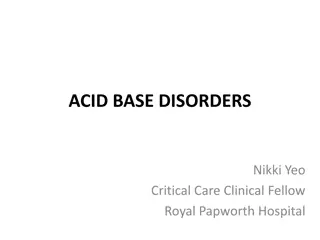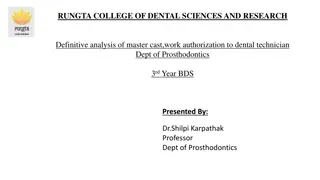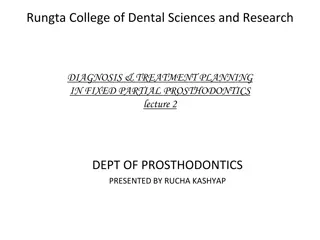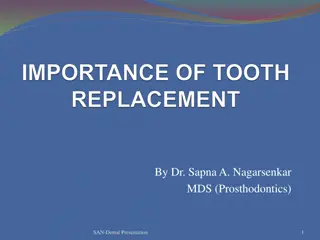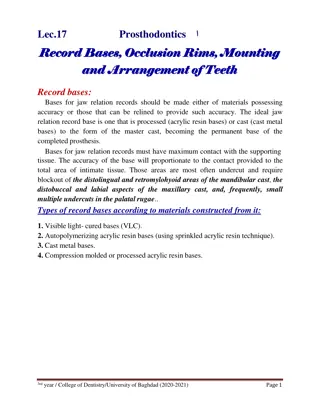Understanding Denture Base Considerations in Prosthodontics
In prosthodontics, denture base considerations play a crucial role in the design and fabrication of removable partial dentures. This comprehensive guide covers the definition, requisites for an ideal denture base, functions, types (plastic and metal), and advantages of metal bases. Key factors such as accuracy of adaptation, esthetics, support for artificial teeth, and resistance to fracture are highlighted. Understanding these aspects is essential for ensuring the success and longevity of denture prosthetics.
Download Presentation

Please find below an Image/Link to download the presentation.
The content on the website is provided AS IS for your information and personal use only. It may not be sold, licensed, or shared on other websites without obtaining consent from the author. Download presentation by click this link. If you encounter any issues during the download, it is possible that the publisher has removed the file from their server.
E N D
Presentation Transcript
DENTURE BASE CONSIDERATIONS DENTURE BASE CONSIDERATIONS Dr. Sunit Jurel Assistant Professor Dept.Of Prosthodontics
DENTURE BASE CONSIDERATIONS DENTURE BASE CONSIDERATIONS Contents.. Definition Requirements Functions Types a,Plastic b,Metal Tooth supported partial denture base Distal extension denture base Methods of attaching denture base Methods of attaching artificial teeth Relining
Definition Denture base is that part of the removable partial denture which rests on oral mucosa and to which teeth are attached .
REQUISITES FOR IDEAL DENTURE BASE Accuracy of Adaptation To Tissues With Low Volume Change Dense non irritating surface capable of receiving & maintaining a good finish. Biocompatible Thermal conductivity Low specific gravity Lightness in mouth Esthetic
Dimensional stability Sufficient strength Resistance to fracture /distortion- Resist deformation Self cleansing Low Cost Potential for future relining
FUNCTIONS Esthetics Support and retain artificial teeth Assist in transfer of occlusal forces directly to abutment teeth through rests. Prevent vertical and horizontal migration of remaining natural teeth. Eliminate undesirable food traps. Stimulates the underlying tissue.
TYPES TYPES Plastic - Acrylic Polystyrene Valplast Metal - Gold Co-Cr Titanium Vitallium
METAL BASE Indications Tooth supported partial dentures Inadequate interarch space Structural details Designed with optimum extension Thinner base than plastic resin Avoid sharp margins
Metal Base - Advantages Accuracy and Permanence of form Comparative tissue response Thermal conductivity Weight & Bulk
Accuracy and permanence of form Cast more accurately than denture resins and maintain their accuracy of form without change in mouth. Need for an additional PPS eliminated entirely. Metal base provides intimacy of contact retention of denture prostheses.
Comparative tissue response Metal base naturally cleaner than an acrylic resin base. Bacteriostatic activity ionization oxidization of metal base.
Thermal conductivity Temperature changes transmitted through metal to the underlying tissues help to maintain health of that tissue. Patient acceptance. Denture base resins insulating property
Weight and bulk Metal alloy may be cast thinner than acrylic resin and still have adequate strength.
Metal Base- Disadvantages Unaesthetic Enhancement of retention not possible Relining difficult Restoration of normal facial contour can not be achieved
Acrylic denture base Indications Extension base partial denture Long span edentulous ridges Relining Contour restoration
Certain situations demands use of acrylic denture base- Extreme loss of residual alveolar bone. Fullness to denture base to restore facial contours. Esthetics
VALPLAST Flexible denture base resin ideal for partial dentures. Esthetics functional alternative to traditional cast metal based removable partial dentures.
Biocompatible nylon and thermoplastic resin-flexibility and stability. Color, shape and design of valplast partials blend with natural appearance of gingiva making prostheses nearly invisible. Strenght of valplast resin doesn t require a metal framework-eliminates metallic taste. Enables partial to be fabricated thin enough with non metallic clasps.
DENTURE BASE ..TYPES Tooth Supported Partial Denture Base DistalExtensionPartial Denture Base
Tooth Supported Partial Denture Base Denture base is primarily a span b/w two abutments supporting artificial teeth. Occlusal forces transferred to abutments-Rests. Prevent horizontal migration and vertical migration of natural teeth .
Distal extension partial denture base Support primary consideration Support critical for minimizing functional movement and improving prostheses stability. Snow shoe principle- broad coverage furnishes the best support with least load per unit area is principle choice for providing max support.
Advantages- Esthetics, Stimulation of underlying tissue Relining Primary retention for RPD mechanically by placing retaining elements on abutment teeth.
Secondary retention- Intimate relationship of denture base and major connectors. Adhesion Cohesion Atmospheric pressure Physiological molding of tissue . Effect of gravity on mandibular denture.
Methods of attaching denture base Acrylic resin bases attached to partial denture frame work-minor connector designed b/w framework and underlying tissue.
12-14 guage half round wax and 18 guage round wax- ladder like framework rather than mesh pattern. Not interfere with teeth arrangement-future adjustment MESH PATTERN/ LADDER LIKE FRAMEWORK BEADS & NAIL HEADS
Methods Of Attaching Artificial Teeth Porcelain/ Resin Artificial Teeth with Resin Porcelain/ Resin Tube Teeth & Facings Cemented Directly to Metal Bases Resin Teeth Processed Directly To Metal Bases Metal Teeth Cast With Frame Work
Porcelain or acrylic resin teeth attached with acrylic resin Porcelain teeth, mechanically retained by acrylic resin denture base in their diatoric holes and retention pins. Acrylic resin teeth retained by chemical union with acrylic resin of denture base. Separation occurring b/w acrylic resin and metal .
Porcelain or resin tube teeth and facings cemented directly to metal bases. Modification of this method is attachment of ready made acrylic resin teeth to the metal base with acrylic resin of same shade(pressing). Particularly applicable for ant replacements.
Disadvantages Difficulties in obtaining satisfactory occlusion. Lack of adequate contours for functional tongue and cheek contact. Unesthetic display of metal at gingival margins.
Resin teeth processed directly to metal bases Occlusal relation established in mouth and transferred to articulator. Teeth can be carved or processed in acrylic resin of proper shade. Long, short,wide or narrow teeth may be created when necessary to fill spaces.
METAL TEETH Occasionally a second molar tooth may be replaced as part of partial denture casting. Space too limited for attachment of an artificial tooth. Should be used only to fill a space and to prevent tooth extrusion.
NEED FOR RELINING Distal extension base differs from tooth supported base- made of material relined. Acrylic resin denture base materials that can be relined.
